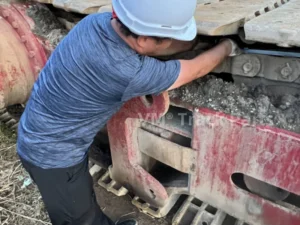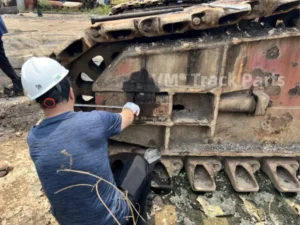
As the core component of crane load-bearing and walking, the state of the track shoe directly determines the safety and service life of the equipment. This guide integrates 28 years of experience in engineering machinery maintenance and provides equipment managers with a systematic crane track shoe inspection solution.
Four major causes of track shoe failure
Extreme load: vertical pressure generated by hoisting operations
Continuous wear: friction loss caused by equipment movement
Environmental erosion: corrosion by site pollutants (acids, alkalis/gravel)
Impact stress: instantaneous impact caused by rugged terrain
Regular inspections can avoid:
- Sudden downtime in key projects
- Early replacement of the track system (cost reduction of 40%+)
- Safety accidents caused by track breakage
- Risk of equipment instability during operation
Three-step precision inspection process
Step 1: Pre-inspection preparation
Park the equipment on level and solid ground
The main arm is completely lowered and locked
Start the safety lock/turn off the engine
Prepare calipers (accuracy 0.01mm), torque wrenches, and flaw detection lights
Step 2: Visual inspection
Crack/deformation investigation (focus on stress concentration areas)
Confirmation of missing/loose bolts (a single track with >30% bolt abnormalities requires replacement of the entire section)
Record of abnormal wear patterns (such as eccentric wear, dents)
Marking of foreign body impact damage
Step 3: Key dimension measurement
Track plate thickness Center point ≥35mm (new part) ≤25mm (Liebherr LR1300)
Inner edge ≥28mm ≤22mm (Manitowoc 999)
Outer edge ≥28mm ≤20mm (Sany SCC8500)
Wear rate calculation formula (Original thickness – current thickness)/original thickness × 100% >50% Replace immediately

Standards for mandatory replacement of track shoes
Replacement is required in the following cases:
Thickness is lower than the manufacturer’s limit (usually 25mm)
3 or more broken plates appear on a single track
Bolt replacement rate >30%/section
Edge curling deformation >5mm
Deep depression on the contact surface
Golden rule for maintenance
Cleaning management: remove gravel/oil stains every shift
Position rotation: replace track shoe installation positions every quarter
Tension control: maintain the manufacturer’s specified value (200-ton class: 80-120kN)
Digital archives: establish a wear trend database
Operation training: standardize steering/climbing operation procedures





